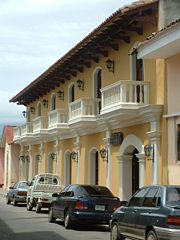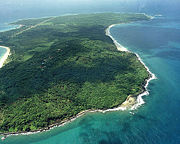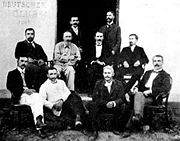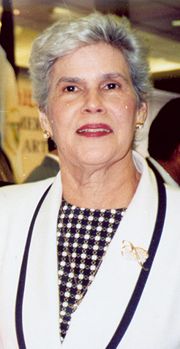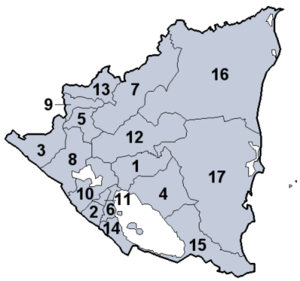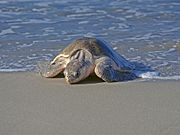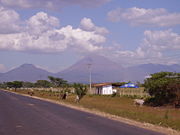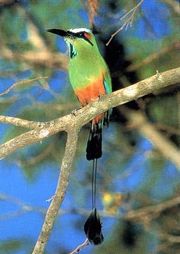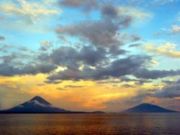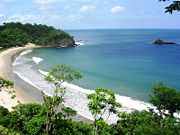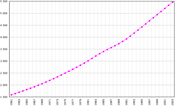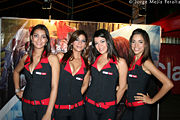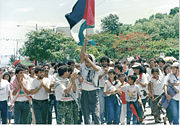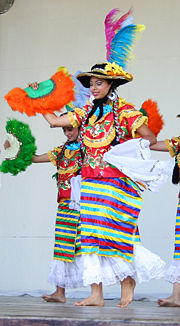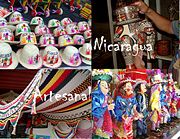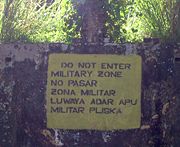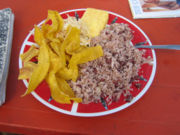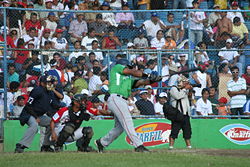Nicaragua
2008/9 Schools Wikipedia Selection. Related subjects: Americas; Countries
| República de Nicaragua Republic of Nicaragua
|
||||||
|---|---|---|---|---|---|---|
|
||||||
| Anthem: Salve a ti, Nicaragua |
||||||
|
|
||||||
| Capital (and largest city) |
Managua |
|||||
| Official languages | Spanish1 | |||||
| Demonym | Nicaraguan | |||||
| Government | Presidential republic | |||||
| - | President | Daniel Ortega ( FSLN) | ||||
| - | Vice President | Jaime Morales Carazo | ||||
| Independence | from Spain | |||||
| - | Declared | September 15, 1821 | ||||
| - | Recognized | July 25, 1850 | ||||
| - | Revolution | July 19, 1979 | ||||
| Area | ||||||
| - | Total | 129,494 km² ( 97th) 50,193 sq mi |
||||
| - | Water (%) | 7.14 | ||||
| Population | ||||||
| - | July 2006 estimate | 5,603,000 ( 107th) | ||||
| - | 2005 census | 5,142,098 | ||||
| - | Density | 42/km² ( 132th) 109/sq mi |
||||
| GDP ( PPP) | 2007 estimate | |||||
| - | Total | $15.839 billion ( 109th) | ||||
| - | Per capita | $3,200 ( 128th) | ||||
| Gini (2001) | 43.1 (medium) | |||||
| HDI (2007) | ▲ 0.710 (medium) ( 110th) | |||||
| Currency | Córdoba ( NIO) |
|||||
| Time zone | ( UTC-6) | |||||
| Internet TLD | .ni | |||||
| Calling code | +505 | |||||
| 1 | English and indigenous languages on Caribbean coast are also spoken. | |||||
Nicaragua (IPA: /ˌnɪkəˈrɑgwə/) officially the Republic of Nicaragua (Spanish: República de Nicaragua ( help· info), Spanish pronunciation: [reˈpuβlika ðe nikaˈɾaɣwa]), is a representative democratic republic and the largest nation in Central America. It is also the least densely populated with a demographic similar in size to its smaller neighbors. The country is bordered by Honduras to the north and by Costa Rica to the south. The Pacific Ocean lies to the west of the country, while the Caribbean Sea lies to the east. Falling within the tropics, Nicaragua sits 11 degrees north of the Equator, in the Northern Hemisphere.
The country's name is derived from Nicarao, the name of the Nahuatl-speaking tribe which inhabited the shores of Lago de Nicaragua before the Spanish conquest of the Americas, and the Spanish word Agua, meaning water, due to the presence of the large lakes Lago de Nicaragua (Cocibolca) and Lago de Managua (Xolotlán), as well as lagoons and rivers in the region.
At the time of the Spanish conquest, Nicaragua was the name given to the narrow strip of land between Lake Nicaragua and the Pacific Ocean. Chief Nicarao ruled over the land when the first conquerors arrived. The term was eventually applied, by extension, to the Nicarao or Niquirano groups that inhabited that region.
The Nicarao tribe migrated to the area from northern regions after the fall of Teotihuacán, on the advice of their religious leaders. According to tradition, they were to travel south until they encountered a lake with two volcanoes rising out of the waters, and so they stopped when they reached Ometepe, the largest fresh-water volcanic island in the world.
History
Pre-Columbian history
In Pre-Columbian times the Indigenous people, in what is now known as Nicaragua, were part of the Intermediate Area located between the Mesoamerican and Andean cultural regions. This has recently been updated to include the influence of the Isthmo-Colombian area. It was the point where the Mesoamerican and South American native cultures met.
Nicaragua was inhabited by Paleo-Indians as far back as 6000 years ago. This is confirmed by the ancient footprints of Acahualinca, along with other archaeological evidence, mainly in the form of ceramics and statues made of volcanic stone like the ones found on the island of Zapatera and petroglyphs found in Ometepe island. At the end of the 15th century, western Nicaragua was inhabited by several indigenous peoples related by culture and language to the Mayans. They were primarily farmers who lived in towns, organized into small kingdoms. Meanwhile, the Caribbean coast of Nicaragua was inhabited by indigenous peoples, mostly chibcha related groups, that had migrated from what is now Colombia. They lived a less sedentary life based on hunting and gathering.
The people of eastern Nicaragua appear to have traded with and been influenced by the native peoples of the Caribbean, as round thatched huts and canoes, both typical of the Caribbean, were common in eastern Nicaragua. In the west and highland areas, occupying the territory between Lake Nicaragua and the Pacific Coast, the Niquirano were governed by chief Nicarao, or Nicaragua, a rich ruler who lived in Nicaraocali, now the city of Rivas. The Chorotega lived in the central region of Nicaragua. These two groups had intimate contact with the Spanish conquerors, paving the way for the racial mix of native and European stock now known as mestizos. However, within three decades an estimated Indian population of one million plummeted to a few tens of thousands, as approximately half of the indigenous people in western Nicaragua died from the rapid spread of new diseases brought by the Spaniards, something the indigenous people of the Caribbean coast managed to escape due to the remoteness of the area.
The Spanish conquest
In 1502, Christopher Columbus was the first European known to have reached what is now Nicaragua as he sailed south along the Central America isthmus. On his fourth voyage Columbus sailed alongside and explored the Mosquito Coast on the east of Nicaragua. The first attempt to conquer what is now known as Nicaragua was by Spanish conquistador Gil González Dávila, whose Central American exploits began with his arrival in Panama in January 1520. González claimed to have converted some 30,000 indigenous peoples and discovered a possible transisthmian water link. After exploring and gathering gold in the fertile western valleys González was attacked by the indigenous people, some of whom were commanded by Nicarao and an estimated 3,000 led by chief Diriangén. González later returned to Panama where governor Pedrarias Dávila attempted to arrest him and confiscate his treasure, some 90,000 pesos of gold. This resulted in González fleeing to Santo Domingo.
It was not until 1524 that the first Spanish permanent settlements were founded. Conquistador Francisco Hernández de Córdoba founded two of Nicaragua's principal towns in 1524: Granada on Lake Nicaragua was the first settlement and León east of Lake Managua came after. Córdoba soon found it necessary to prepare defenses for the cities and go on the offensive against incursions by the other conquistadores. Córdoba was later publicly beheaded following a power struggle with Pedrarias Dávila, his tomb and remains were discovered some 500 years later in the Ruins of León Viejo.
The inevitable clash between the Spanish forces did not impede their devastation of the indigenous population. The Indian civilization was destroyed. The series of battles came to be known as The War of the Captains. By 1529, the conquest of Nicaragua was complete. Several conquistadores came out winners, and some were executed or murdered. Pedrarias Dávila was a winner; although he had lost control of Panama, he had moved to Nicaragua and established his base in León. Through adroit diplomatic machinations, he became the first governor of the colony. The land was parceled out to the conquistadores. The area of most interest was the western portion. Many indigenous people were soon enslaved to develop and maintain "estates" there. Others were put to work in mines in northern Nicaragua, few were killed in warfare, and the great majority were sent as slaves to other New World Spanish colonies, for significant profit to the new landed aristocracy. Many of the indigenous people died as a result of disease and neglect by the Spaniards who controlled everything necessary for their subsistence.
From colony to nation
In 1538, the Viceroyalty of New Spain was established. By 1570, the southern part of New Spain was designated the Captaincy General of Guatemala. The area of Nicaragua was divided into administrative "parties" with León as the capital. In 1610, the Momotombo erupted, destroying the capital. It was rebuilt northwest of what is now known as the Ruins of Old León. Nicaragua became a part of the Mexican Empire and then gained its independence as a part of the United Provinces of Central America in 1821 and as an independent republic in its own right in 1838. The Mosquito Coast based on the Caribbean coast was claimed by the United Kingdom and its predecessors as a protectorate from 1655 to 1850; this was delegated to Honduras in 1859 and transferred to Nicaragua in 1860, though it remained autonomous until 1894. Jose Santos Zelaya, president of Nicaragua from 1893-1909, managed to negotiate for the annexation of this region to the rest of Nicaragua. In his honour the entire region was named Zelaya.
Much of Nicaragua's politics since independence has been characterized by the rivalry between the liberal elite of León and the conservative elite of Granada. The rivalry often degenerated into civil war, particularly during the 1840s and 1850s. Initially invited by the Liberals in 1855 to join their struggle against the Conservatives, a United States adventurer named William Walker (later executed in Honduras) set himself up as president of Nicaragua, after conducting a farcical election in 1856. Honduras and other Central American countries united to drive him out of Nicaragua in 1857, after which a period of three decades of Conservative rule ensued.
In the 1800s Nicaragua experienced a wave of immigration, primarily from Europe. In particular, families from Germany, Italy, Spain, France and Belgium generally moved to Nicaragua to set up businesses with money they brought from Europe. They established many agricultural businesses such as coffee and sugar cane plantations, and also newspapers, hotels and banks.
United States involvement (1909 - 1933)
In 1909, the United States provided political support to conservative-led forces rebelling against President Zelaya. U.S. motives included differences over the proposed Nicaragua Canal, Nicaragua's potential as a destabilizing influence in the region, and Zelaya's attempts to regulate foreign access to Nicaraguan natural resources. On November 18, 1909, U.S. warships were sent to the area after 500 revolutionaries (including two Americans) were executed by order of Zelaya. The U.S. justified the intervention by claiming to protect U.S. lives and property. Zelaya resigned later that year. U.S. Marines occupied Nicaragua from 1912 to 1933, except for a nine month period beginning in 1925. From 1910 to 1926, the conservative party ruled Nicaragua. The Chamorro family, which had long dominated the party, effectively controlled the government during that period. In 1914, the Bryan-Chamorro Treaty was signed, giving the U.S. control over the proposed canal, as well as leases for potential canal defenses. Following the evacuation of U.S. marines, another violent conflict between liberals and conservatives took place in 1926, known as the Constitutionalist War, which resulted in a coalition government and the return of U.S. Marines.
From 1927 until 1933, Gen. Augusto César Sandino led a sustained guerrilla war first against the Conservative regime and subsequently against the U.S. Marines, who withdrew upon the establishment of a new Liberal government. Sandino was the only Nicaraguan general to refuse to sign the el tratado del Espino Negro agreement and then headed up to the northern mountains of Las Segovias, where he fought the US Marines for over five years. The revolt finally forced the United States to compromise and leave the country. When the Americans left in 1933, they set up the Guardia Nacional (National Guard), a combined military and police force trained and equipped by the Americans and designed to be loyal to U.S. interests. Anastasio Somoza García, a close friend of the American government, was put in charge. He was one of the three rulers of the country, the others being Sandino and the mostly figurehead President Juan Bautista Sacasa.
After the US Marines withdrew from Nicaragua in January 1933, Sandino and the newly-elected Sacasa government reached an agreement by which he would cease his guerrilla activities in return for amnesty, a grant of land for an agricultural colony, and retention of an armed band of 100 men for a year. But a growing hostility between Sandino and Somoza led Somoza to order the assassination of Sandino. Fearing future armed opposition from Sandino, Somoza invited him to a meeting in Managua, where Sandino was assassinated on February 21 of 1934 by the National Guard. Hundreds of men, women, and children were executed later.
The Somoza Dynasty (1936 - 1979)
Nicaragua has seen many interventions by the United States. It has also experienced long military dictatorships, the longest one being the rule of the Somoza family for much of the 20th century. The Somoza family came to power as part of a US-engineered pact in 1927 that stipulated the formation of the National Guard to replace the small individual armies that had long reigned in the country. Somoza deposed Sacasa and became president on Jan. 1, 1937 in a rigged election.
Nicaragua was the first country to ratify the UN Charter, and declared war on Germany during World War II. No troops were sent to the war but Somoza did seize the occasion to confiscate attractive properties held by German-Nicaraguans, the best-known of which was the Montelimar estate which today operates as a privately-owned luxury resort and casino.
Somoza used the National Guard to force Sacasa to resign, and took control of the country in 1937, destroying any potential armed resistance. Somoza was in turn assassinated by Rigoberto López Pérez, a liberal Nicaraguan poet, in 1956. After his father's death, Luis Somoza Debayle, the eldest son of the late dictator, was appointed President by the congress and officially took charge of the country. He is remembered by some for being moderate, but was in power only for a few years and then died of a heart attack. Then came president Rene Schick whom most Nicaraguans viewed "as nothing more than a puppet of the Somozas". Somoza's brother, Anastasio Somoza Debayle, who succeeded his father in charge of the National Guard, controlled the country, and officially took the presidency after Schick.
Nicaragua experienced high economic growth during the 1960s and 1970s largely as a result of industrialization, and became one of Central America's most developed nations despite its political instability. Due to its stable and high growth economy, foreign investments grew, primarily from U.S. companies such as Citigroup, Sears, Westinghouse and Coca Cola. However, the capital city of Managua suffered a major earthquake in 1972 which destroyed nearly 90% of the city creating major losses. Some Nicaraguan historians see the 1972 earthquake that devastated Managua as the final 'nail in the coffin' for Somoza. The mishandling of relief money also prompted Pittsburgh Pirates star Roberto Clemente to personally fly to Managua on December 31, 1972, but he died enroute in an airplane accident. Even the economic elite were reluctant to support Somoza, as he had acquired monopolies in industries that were key to rebuilding the nation, and did not allow the elite to share the profits that would result. In 1973 (the year of reconstruction) many new buildings were built, but the level of corruption in the government prevented further growth, and the ever increasing tensions and anti-government uprisings slowed growth in the last two years of the Somoza dynasty.
The Nicaraguan revolution
In 1961, a young student, Carlos Fonseca, turned back to the historical figure of Sandino, and along with 2 others founded the Sandinista National Liberation Front (FSLN). The FSLN was a tiny party throughout most of the 1960s, but Somoza's utter hatred of it and his heavy-handed treatment of anyone he suspected to be a Sandinista sympathizer gave many ordinary Nicaraguans the idea that the Sandinistas were much stronger.
After the 1972 earthquake and Somoza's brazen corruption, mishandling of relief, and refusal to rebuild Managua, the ranks of the Sandinistas were flooded with young disaffected Nicaraguans who no longer had anything to lose. These economic problems propelled the Sandinistas in their struggle against Somoza by leading many middle- and upper-class Nicaraguans to see the Sandinistas as the only hope for removing the brutal Somoza regime. On January 1978, Pedro Joaquin Chamorro, the editor of the national newspaper La Prensa and ardent opponent of Somoza, was assassinated. This is believed to have led to the extreme general disappointment with Somoza. The planners and perpetrators of the murder were at the highest echelons of the Somoza regime and included the dictator's son, “El Chiguin”, the President of Housing, Cornelio Hueck, the Attorney General, and Pedro Ramos, a close Cuban ally who commercialized blood plasma.
The Sandinistas, supported by much of the populace, elements of the Catholic Church, and regional and international governments, took power in July of 1979. Somoza fled the country and eventually ended up in Paraguay, where he was assassinated in September 1980, allegedly by members of the Argentinian Revolutionary Workers Party. The Sandinistas inherited a country in ruins with a debt of U.S.$1.6 billion dollars, an estimated 50,000 war dead, 600,000 homeless, and a devastated economic infrastructure. To begin the task of establishing a new government, they created a Council (or junta) of National Reconstruction, made up of five members – Sandinista militants Daniel Ortega and Moises Hassan, novelist Sergio Ramírez Mercado (a member of Los Doce "the Twelve"), businessman Alfonso Robelo Callejas, and Violeta Barrios de Chamorro (the widow of Pedro Joaquín Chamorro). The preponderance of power, however, remained with the Sandinistas and their mass organizations, including the Sandinista Workers' Federation (Central Sandinista de Trabajadores), the Luisa Amanda Espinoza Nicaraguan Women's Association (Asociación de Mujeres Nicaragüenses Luisa Amanda Espinoza), and the National Union of Farmers and Ranchers (Unión Nacional de Agricultores y Ganaderos).
Sandinistas and the Contras
Upon assuming office in 1981, U.S. President Ronald Reagan condemned the FSLN for joining with Cuba in supporting Marxist revolutionary movements in other Latin American countries such as El Salvador. His administration authorized the CIA to begin financing, arming and training rebels, some of whom were the remnants of Somoza's National Guard, as anti-Sandinista guerrillas that were branded "counter-revolutionary" by leftists (contrarrevolucionarios in Spanish). This was shortened to Contras, a label the anti-Communist forces chose to embrace. Eden Pastora and many of the indigenous guerrilla forces, who were not associated with the "Somozistas," also resisted the Sandinistas. The Contras operated out of camps in the neighboring countries of Honduras to the north and Costa Rica to the south. As was typical in guerrilla warfare, they were engaged in a campaign of economic sabotage in an attempt to combat the Sandinista government and disrupted shipping by planting underwater mines in Nicaragua's Corinto harbour, an action condemned by the World Court as illegal. The U.S. also sought to place economic pressure on the Sandinistas, and the Reagan administration imposed a full trade embargo.
U.S. support for this Nicaraguan insurgency continued in spite of the fact that impartial observers from international groupings such as the European Union, religious groups sent to monitor the election, and observers from democratic nations such as Canada and the Republic of Ireland concluded that the Nicaraguan general elections of 1984 were completely free and fair. The Reagan administration disputed these results however, despite the fact that the government of the United States never had any observers in Nicaragua at the time.
After the U.S. Congress prohibited federal funding of the Contras in 1983, the Reagan administration continued to back the Contras by covertly selling arms to Iran and channeling the proceeds to the Contras (The Iran-Contra Affair). When this scheme was revealed, Reagan admitted that he knew about the Iranian "arms for hostages" dealings but professed ignorance about the proceeds funding the Contras; for this, National Security Council aide Lt. Col. Oliver North took much of the blame. Senator John Kerry's 1988 U.S. Senate Committee on Foreign Relations report on Contra-drug links concluded that "senior U.S. policy makers were not immune to the idea that drug money was a perfect solution to the Contras' funding problems." According to the National Security Archive, Oliver North had been in contact with Manuel Noriega, a Panamanian general and the de facto military dictator of Panama from 1983 to 1989 when he was overthrown and captured by a U.S. invading force. He was taken to the United States, tried for drug trafficking, and imprisoned in 1992.
The Reagan administration's support for the Contras continued to stir controversy well into the 1990s. In August 1996, San Jose Mercury News reporter Gary Webb published a series titled Dark Alliance, linking the origins of crack cocaine in California to the Contras. Freedom of Information Act inquiries by the National Security Archive and other investigators unearthed a number of documents showing that White House officials, including Oliver North, knew about and supported using money raised via drug trafficking to fund the Contras. Sen. John Kerry's report in 1988 led to the same conclusions; however, major media outlets, the Justice Department, and Reagan denied the allegations.
1990s and the post-Sandinista era
Multi-party democratic elections were held in 1990, which saw the defeat of the Sandinistas by a coalition of anti-Sandinista (from the left and right of the political spectrum) parties led by Violeta Chamorro, the widow of Pedro Joaquín Chamorro. The defeat shocked the Sandinistas as numerous pre-election polls had indicated a sure Sandinista victory and their pre-election rallies had attracted crowds of several hundred thousand people. The unexpected result was subject to a great deal of analysis and comment, and was attributed by commentators such as Noam Chomsky and S. Brian Willson to the U.S./ Contra threats to continue the war if the Sandinistas retained power, the general war-weariness of the Nicaraguan population, and the abysmal Nicaraguan economic situation.
On the other hand, P. J. O'Rourke wrote in "Return of the Death of Communism", "the unfair advantages of using state resources for party ends, about how Sandinista control of the transit system prevented UNO supporters from attending rallies, how Sandinista domination of the army forced soldiers to vote for Ortega and how Sandinista bureaucracy kept $3.3 million of U.S. campaign aid from getting to UNO while Daniel Ortega spent millions donated by overseas people and millions and millions more from the Nicaraguan treasury . . ."
Exit polls of Nicaraguans reported Chamorro's victory over Ortega was achieved with only 55%. Violeta Chamorro was the first woman to be popularly elected as President of a Latin American nation and first woman president of Nicaragua. Exit polling convinced Daniel Ortega that the election results were legitimate, and were instrumental in his decision to accept the vote of the people and step down rather than void the election. Nonetheless Ortega vowed that he would govern "desde abajo" (from below), in other words due to his widespread control of institutions and Sandinista individuals in all government agencies, he would still be able to maintain control and govern even without being president.
Chamorro received an economy entirely in ruins. The per capita income of Nicaragua had been reduced by over 80% during the 1980s, and a huge government debt which ascended to US$12 billion primarily due to financial and social costs of the Contra war with the Sandinista-led government. Much to the surprise of the U.S. and the contra forces, Chamorro did not dismantle the Sandinista People's Army, though the name was changed to the Nicaraguan Army. Chamorro's main contribution to Nicaragua was the disarmament of groups in the northern and central areas of the country. This provided stability that the country had lacked for over ten years.
In subsequent elections in 1996 Daniel Ortega and the Sandinistas of the FSLN were again defeated, this time by Arnoldo Alemán of the Constitutional Liberal Party (PLC).
In the 2001 elections the PLC again defeated the FSLN, with Enrique Bolaños winning the Presidency. However, President Bolaños subsequently charged and brought forward allegations of money laundering, theft and corruption against former President Alemán. The ex-president was sentenced to 20 years in prison for embezzlement, money laundering, and corruption. The Liberal members who were loyal to Alemán and also members of congress reacted angrily, and along with Sandinista parliament members stripped the presidential powers of President Bolaños and his ministers, calling for his resignation and threatening impeachment.
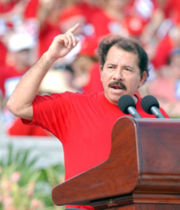
The Sandinistas alleged that their support for Bolaños was lost when U.S. Secretary of State Colin Powell told Bolaños to keep his distance from the FSLN. This "slow motion coup" was averted partially due to pressure from the Central American presidents who would fail to recognize any movement that removed Bolaños; The U.S., the OAS, and the European Union also opposed the "slow motion coup". The proposed constitutional changes that were going to be introduced in 2005 against the Bolaños administration were delayed until January 2007 after the entrance of the new government. Though one day before they were to be enforced, the National Assembly postponed their enforcement until January 2008.
Before the general elections on 5 November 2006, the National Assembly passed a bill further restricting abortion in Nicaragua 52-0 (9 abstaining, 29 absent). President Enrique Bolaños supported this measure, but signed the bill into law on 17 November 2006, as a result Nicaragua is one of three countries in the world where abortion is illegal with no exceptions, along with El Salvador and Chile.
Legislative and presidential elections took place on November 5, 2006. Daniel Ortega returned to the presidency with 37.99% of the vote. This percentage was enough to win the presidency outright, due to a change in electoral law which lowered the percentage requiring a runoff election from 45% to 35% (with a 5% margin of victory).
Politics
Politics of Nicaragua takes place in a framework of a presidential representative democratic republic, whereby the President of Nicaragua is both head of state and head of government, and of a multi-party system. Executive power is exercised by the government. Legislative power is vested in both the government and the National Assembly. The Judiciary is independent of the executive and the legislature.
Departments and municipalities
Nicaragua is a unitary republic. For administrative purposes it is divided into 15 departments (departamentos) and two self-governing regions (autonomous communities) based on the Spanish model. The departments are then subdivided into 153 municipios ( municipalities). The two autonomous regions are Región Autónoma del Atlántico Norte and Región Autónoma del Atlántico Sur, often referred to as RAAN and RAAS, respectively. Until they were granted autonomy in 1985 they formed the single department of Zelaya.
|
|
Geography
Nicaragua occupies a landmass of 129,494 km² - roughly the size of Greece or the state of New York and 1.5 times larger than Portugal. Close to 20% of the country's territory is designated as protected areas such as national parks, nature reserves and biological reserves. The country is bordered by Costa Rica on the south and Honduras on the north, with the Caribbean Sea to the east and the Pacific Ocean to the west.
Nicaragua has three distinct geographical regions: the Pacific Lowlands, the North-Central Mountains or highlands and the Atlantic Lowlands.
Pacific lowlands
Located in the west of the country, these lowlands consist of a broad, hot, fertile plain. Punctuating this plain are several large volcanoes of the Marrabios mountain range, including Mombacho just outside Granada, and Momotombo near León. The lowland area runs from the Gulf of Fonseca to Nicaragua's Pacific border with Costa Rica south of Lake Nicaragua. Lake Nicaragua is the largest freshwater lake in Central America (20th largest in the world), and is home to the world's only freshwater sharks (Nicaraguan shark). The Pacific lowlands region is the most populous, with over half of the nation's population. The capital city of Managua is the most populous and it is the only city with over 1 million inhabitants.
In addition to its beach and resort communities, the Pacific Lowlands is also the repository for much of Nicaragua's Spanish colonial heritage. Cities such as Granada and León abound in colonial architecture and artifacts. Granada, founded in 1524, is the oldest colonial city in the Americas.
Central highlands
This is an upland region away from the Pacific coast, with a cooler climate than the Pacific Lowlands. About a quarter of the country's agriculture takes place in this region, with coffee grown on the higher slopes. Oaks, pines, moss, ferns and orchids are abundant in the cloud forests of the region.
Bird life in the forests of the central region includes Resplendent Quetzal, goldfinches, hummingbirds, jays and toucanets.
Atlantic lowlands
This large rainforest region, with several large rivers running through it, is very sparsely populated. The Rio Coco is the largest river in Central America, it forms the border with Honduras. The Caribbean coastline is much more sinuous than its generally straight Pacific counterpart. Lagoons and deltas make it very irregular.
Nicaragua's Bosawas Biosphere Reserve is located in the Atlantic lowlands, it protects 1.8 million acres (7,300 km²) of Mosquitia forest - almost seven percent of the country's area - making it the largest rainforest north of the Amazon in Brazil.
Nicaragua's tropical east coast is very different from the rest of the country. The climate is predominantly tropical, with high temperature and high humidity. Around the area's principal city of Bluefields, English is widely spoken along with the official Spanish and the population more closely resembles that found in many typical Caribbean ports than the rest of Nicaragua.
A great variety of birds can be observed including eagles, turkeys, toucans, parakeets and macaws. Animal life in the area includes different species of monkeys, ant-eaters, white-tailed deer and tapirs.
Economy
Nicaragua's economy ranks as 61st freest economy, although it is 1.7% lower than in 2006, it ranks 14 (out of 29) in the Americas. Nicaragua's economy is 62.7% free with high levels of fiscal, government, labor, investment, financial, and trade freedom. Nicaragua is primarily an agricultural country, but light industry (maquila), tourism, banking, mining, fisheries, and general commerce are expanding. Nicaragua's agrarian economy has historically been based on the export of cash crops such as bananas, coffee, sugar, beef and tobacco. At present agriculture constitutes 60% of its total exports which annually yield approximately US $300 million. In addition, Nicaragua's Flor de Caña rum is renowned as among the best in Latin America, and its tobacco and beef are also well regarded. Nicaragua also depends heavily on remittances from Nicaraguans living abroad, which totaled $655.5 million in 2006. During the war between the Contras and the Sandinistas in the 1980s, much of the country's infrastructure was damaged or destroyed. Inflation averaged 30% throughout the 1980s. After the United States imposed a trade embargo in 1985, which lasted 5 years, Nicaragua's inflation rate rose dramatically. The 1985 annual rate of 220% tripled the following year and skyrocketed to more than 13,000% in 1988, the highest rate for any country in the Western Hemisphere in that year. Since the end of the war almost two decades ago, more than 350 state enterprises were privatized, reducing inflation from 33,500% in 1988 to 9.45% in 2006, and cutting the foreign debt in half.
Though sources give slightly differing data on the country's gross domestic product (GDP), Nicaragua is one of the smallest economies in the Western Hemisphere. According to the CIA Fact Book, inflation averaged 8.1% from 2000 through 2006. As of 2007, Nicaragua's inflation stands at 9.8%. The World Bank also indicates moderate economic growth at an average of 5% from 1995 through 2004. In 2005 the economy grew 4%, with overall GDP reaching $4.91 billion. In 2006, the economy expanded by 3.7% as GDP reached $5.3 billion. According to the United Nations, 28% of the population in Nicaragua live in poverty (2006 est), unemployment is 3.1%, and another 46.5% are underemployed (2007 est.).
As in many other developing countries, a large segment of the economically poor in Nicaragua are women. In addition, a relatively high proportion of Nicaragua's average homes have a woman as head of household: 39% of urban homes and 28% of rural homes.
The country is still a recovering economy and it continues to implement further reforms, on which aid from the IMF is conditional. In 2005 finance ministers of the leading eight industrialized nations ( G-8) agreed to forgive some of Nicaragua's foreign debt, as part of the HIPC program. According to the World Bank Nicaragua's GDP was around $4.9 US billion dollars. Recently, in March 2007, Poland and Nicaragua signed an agreement to write off 30.6 million dollars which was borrowed by the Nicaraguan government in the 1980s.
According to the World Bank, Nicaragua ranked as the 62nd best economy for starting a business making it the second best in Central America, after Panama.
The Nicaraguan unit of currency is the Córdoba (NIO) and was named after Francisco Hernández de Córdoba, its national founder.
Components of the economy
Gross Domestic Product (GDP) in purchasing power parity (PPP) in 2007 was estimated at $18.17 billion USD. The service sector is the largest component of GDP at 56.9%, followed by the industrial sector at 25.9% (2006 est.). Agriculture represents only 17.1% of GDP (2007 est.). Nicaraguan labor force is estimated at 2.262 million of which 29% is occupied in agriculture, 19% in the industry sector and 52% in the service sector (est. 2007).
Tourism
Tourism in Nicaragua is booming, it is currently the second largest industry in the nation, over the last 7 years tourism has grown about 70% nationwide with rates of 10%-16% annually. Nicaragua has seen positive growth in the tourism sector over the last decade and is expected to become the first largest industry in 2007. The increase and growth led to the income from tourism to rise more than 300% over a period of 10 years. The growth in tourism has also positively affected the agricultural, commercial, and finance industries, as well as the construction industry. Despite the positive growth throughout the last decade, Nicaragua remains the least visited nation in the region.
Every year about 60,000 U.S. citizens visit Nicaragua, primarily business people, tourists, and those visiting relatives.Some 5,300 people from the U.S. reside in the country now. The majority of tourists that visit Nicaragua are from the U.S., Central or South America, and Europe. According to the Ministry of Tourism of Nicaragua (INTUR), the colonial city of Granada is the preferred spot for tourists. Also, the cities of León, Masaya, Rivas and the likes of San Juan del Sur, San Juan River, Ometepe, Mombacho Volcano, the Corn Islands, and others are main tourist attractions. In addition, ecotourism and surfing attract many tourists to Nicaragua.
According to TV Noticias (news program) on Canal 2, a Nicaragua television station, the main attractions in Nicaragua for tourists are the beaches, scenic routes, the architecture of cities such as León and Granada and most recently ecotourism and agritourism, particularly in Northern Nicaragua.
Demographics
Population
According to the CIA World Factbook, Nicaragua has a population of 5,570,129; 69% mestizo, 17% white, 9% black and 5% amerindian. Nicaraguan demographics reflected a different composition prior to the Sandinista revolution of 1979. Most of the migration during the years that followed were primarily of white upper or middle class Nicaraguans. A growing number of these expats have been returning although the vast majority remain living abroad. There is also large and ever growing expatriate (expat) community of people of all ages, the majority of whom move for business, investment or who are retirees. The expat communities include people from United States, Canada, Europe, Taiwan, and other countries, the majority have settled in Managua, Granada and San Juan del Sur.
The most populous city in Nicaragua is the capital city, Managua, with a population of 1.2 million (2005). As of 2005, over 4.4 million inhabitants live in the Pacific, Central and North regions, 2.7 in the Pacific region alone, while inhabitants in the Caribbean region only reached an estimated 700,000. The population is 54% urban and many Nicaraguans live abroad, outside of Nicaragua.
Ethnic groups
The majority of the Nicaraguan population is Mestizo and White. Exactly 69% are Mestizos (mixed Amerindian and White) and 17% are White with the majority being of Spanish, German, Italian, or French ancestry. Mestizos and Whites mainly reside in the western region of the country and combined make up 86% of the Nicaraguan population, approximately 4.8 million people.
About 9% of Nicaragua's population is black, or Afro-Nicaragüense, and mainly reside on the country's sparsely populated Caribbean or Atlantic coast. The black population is mostly of West Indian (Antillean) origin, the descendants of indentured laborers brought mostly from Jamaica when the region was a British protectorate. Nicaragua has the largest Afro Latin American population in Central America with the second largest percentage. There is also a smaller number of Garifuna, a people of mixed Carib, Angolan, Congolese and Arawak descent.
The remaining 5% are Amerindians, the unmixed descendants of the country's indigenous inhabitants. Nicaragua's pre-Colombian population consisted of many indigenous groups. In the western region the Nicarao people, whom the country is named after, were present along with other groups related by culture and language to the Mayans. The Caribbean coast of Nicaragua was inhabited by indigenous peoples who were mostly chibcha related groups that had migrated from South America, primarily present day Colombia and Venezuela. These groups include the Miskitos, Ramas and Sumos. In the nineteenth century, there was a substantial indigenous minority, but this group was also largely assimilated culturally into the mestizo majority. In the mid-1980s, the government divided the department of Zelaya - consisting of the eastern half of the country - into two autonomous regions and granted the black and indigenous people of this region limited self-rule within the Republic.
Immigration
In the 1800s Nicaragua experienced several waves of immigration, primarily from Europe. In particular, families from Germany, Italy, Spain, France and Belgium immigrated to Nicaragua, particularly the departments in the Central and Pacific region. As a result, the Northern cities of Esteli, Jinotega and Matagalpa have significant fourth generation Germans. They established many agricultural businesses such as coffee and sugar cane plantations, and also newspapers, hotels and banks.
Also present is a small Middle Eastern-Nicaraguan community of Syrians, Armenians, Palestinian Nicaraguans, Jewish Nicaraguans, and Lebanese people in Nicaragua with a total population of about 30,000. There is also an East Asian community mostly consisting of Chinese, Taiwanese, and Japanese. The Chinese Nicaraguan population is estimated at around 12,000. The Chinese arrived in the late 1800s but were unsubstantiated until the 1920s.
Relative to its overall population, Nicaragua has never experienced any large scale wave of immigrants. The total number of immigrants to Nicaragua, both originating from other Latin American countries and all other countries, never surpassed 1% of its total population prior to 1995. The 2005 census showed the foreign-born population at 1.2%, having risen a mere .06% in 10 years. This is not to say that immigrants were not important to the evolution of Nicaragua or the Nicaraguan society.
Culture
Nicaraguan culture has strong folklore, music and religious traditions, deeply influenced by European culture but enriched with Amerindian sounds and flavours. Nicaraguan culture can further be defined in several distinct strands. The Pacific coast has strong folklore, music and religious traditions, deeply influenced by Europeans. It was colonized by Spain and has a similar culture to other Spanish-speaking Latin American countries. The Caribbean coast of the country, on the other hand, was once a British protectorate. English is still predominant in this region and spoken domestically along with Spanish and indigenous languages. Its culture is similar to that of Caribbean nations that were or are British possessions, such as Jamaica, Belize, The Cayman Islands, etc. The indigenous groups that were present in the Pacific coast have largely been assimilated into the mestizo culture, however, the indigenous people of the Caribbean coast have maintained a distinct identity.
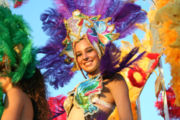
Nicaraguan music is a mixture of indigenous and European, especially Spanish, influences. Musical instruments include the marimba and others common across Central America. The marimba of Nicaragua is uniquely played by a sitting performer holding the instrument on his knees. He is usually accompanied by a bass fiddle, guitar and guitarrilla (a small guitar like a mandolin). This music is played at social functions as a sort of background music. The marimba is made with hardwood plates, placed over bamboo or metal tubes of varying lengths. It is played with two or four hammers. The Caribbean coast of Nicaragua is known for a lively, sensual form of dance music called Palo de Mayo which is very much alive all throughout the country. It is especially loud and celebrated during the Palo de Mayo festival in May. The Garifuna community exists in Nicaragua and is known for its popular music called Punta.
Literature of Nicaragua can be traced to pre-Columbian times with the myths and oral literature that formed the cosmogonic view of the world that indigenous people had. Some of these stories are still know in Nicaragua. Like many Latin American countries, the Spanish conquerors have had the most effect on both the culture and the literature. Nicaraguan literature has historically been an important source of poetry in the Spanish-speaking world, with internationally renowned contributors such as Rubén Darío who is regarded as the most important literary figure in Nicaragua, referred to as the "Father of Modernism" for leading the modernismo literary movement at the end of the 19th century. Other literary figures include Ernesto Cardenal, Gioconda Belli, Claribel Alegría and Jose Coronel Urtecho, among others.
El Güegüense is a satirical drama and was the first literary work of pre-Columbian Nicaragua. It is regarded as one of Latin America's most distinctive colonial-era expressions and as Nicaragua's signature folkloric masterpiece combining music, dance and theatre. The theatrical play was written by an anonymous author in the 16th century, making it one of the oldest indigenous theatrical/dance works of the Western Hemisphere. The story was published in a book in 1942 after many centuries.
Language
Spanish is spoken by about 90% of the country's population. In Nicaragua the Voseo form is common, just as in other countries in Central and South America like Honduras, El Salvador, Argentina, Uruguay or coastal Colombia. Spanish has many different dialects spoken throughout Latin America, Central American Spanish is the dialect spoken in Nicaragua. In the Caribbean coast many afro-Nicaraguans and creoles speak English and creole English as their first language. Also in the Caribbean coast, many Indigenous people speak their native languages, such as the Miskito, Sumo, Rama and Garifuna language. In addition, many ethnic groups in Nicaragua, such as the Chinese Nicaraguans and Palestinian Nicaraguans, have maintained their ancestral languages, which are minority languages, while also speaking Spanish or English. These minority languages include Chinese, Arabic, German, and Italian, among others.
Nicaragua has a total of 3 extinct languages, one of which was never classified. Nicaraguan Sign Language is also of particular interest to linguists.
Religion
| Religious Affiliation in Nicaragua | |
 |
|
| The Metropolitan Cathedral of the Immaculate Conception in Managua | |
| Religion | Percentage |
|---|---|
| Roman Catholic | 58.5% |
| Evangelical | 21.6% |
| Moravian | 1.6% |
| Jehovah's Witnesses | 0.9% |
| None | 15.7% |
| Other1 | 1.6% |
| 1 Includes Buddhism, Islam, and Judaism among other religions. | |
| Source: 2005 Nicaraguan Census | |
Religion is a significant part of the culture of Nicaragua and forms part of the constitution. Religious freedom, which has been guaranteed since 1939, and religious tolerance is promoted by both the Nicaraguan government and the constitution. Bishops are expected to lend their authority to important state occasions, and their pronouncements on national issues are closely followed. They can also be called upon to mediate between contending parties at moments of political crisis.
Nicaragua has no official religion. The largest denomination, and traditionally the religion of the majority, is Roman Catholic. However, practicing Roman Catholics have been declining, while evangelical Protestant groups and Mormons have been rapidly growing since the 1990s. There are also strong Anglican and Moravian communities on the Caribbean coast.
Roman Catholicism came to Nicaragua in the sixteenth century with the Spanish conquest and remained, until 1939, the established faith. Protestantism and other Christian denominations came to Nicaragua during the nineteenth century, but only during the twentieth century have Protestant denominations gained large followings in the Caribbean Coast of the country. Popular religion revolves around the saints, who are perceived as intermediaries between human beings and God. Most localities, from the capital of Managua to small rural communities, honour patron saints, selected from the Roman Catholic calendar, with annual fiestas. In many communities, a rich lore has grown up around the celebrations of patron saints, such as Managua's Saint Dominic (Santo Domingo), honored in August with two colorful, often riotous, day-long processions through the city. The high point of Nicaragua's religious calendar for the masses is neither Christmas nor Easter, but La Purísima, a week of festivities in early December dedicated to the Immaculate Conception, during which elaborate altars to the Virgin Mary are constructed in homes and workplaces.
Cuisine
The Cuisine of Nicaragua is as diverse as its inhabitants. It is a mixture of criollo style food and pre-Columbian dishes. When the Spaniards first arrived in Nicaragua they found that the Creole people present had incorporated foods available in the area into their cuisine. Despite the blending and incorporation of pre-Columbian and Spanish influenced cuisine, traditional cuisine changes from the Pacific to the Caribbean coast. While the Pacific coast's main staple revolves around local fruits and corn, the Caribbean coast's cuisine makes use of seafood and the coconut.
Gallopinto is Nicaragua's national dish, it consists of red beans and rice. The dish has several variations including the addition of coconut oil and/or grated coconut which is primarily prepared on Nicaragua's Caribbean coast. Most Nicaraguans begin and end every day with Gallopinto, it is also thought to have originated in Nicaragua, however there is some controversy about the origins of this dish.
Main staple
As in many other Latin American countries, corn is a main staple. Corn is used in many of the widely consumed dishes, such as the nacatamal, and indio viejo. Corn is not only used in food it is also an ingredient for drinks such as pinolillo and chicha as well as in sweets and desserts. Nicaraguans do not limit their cuisine to corn, local grown vegetables and fruits have been in use since before the arrival of the Spaniards and their influence on Nicaraguan cuisine. Many of Nicaragua's dishes include fruits and vegetables such as jocote, mango, papaya, tamarindo, pipian, banana, avocado, yuca, and herbs such as cilantro, oregano and achiote.
Education
Education is free for all Nicaraguans. Elementary education is free and compulsory, however, many children in rural areas are unable to attend due to lack of schools and other reasons. Communities located on the Caribbean coast have access to education in their native languages. The majority of higher education institutions are located in Managua, higher education has financial, organic and administrative autonomy, according to the law. Also, freedom of subjects is recognized.
Nicaragua's higher education consists of 48 universities and 113 colleges and technical institutes which serve student in the areas of electronics, computer systems and sciences, agroforestry, construction and trade-related services. The educational system includes 1 U.S. accredited English-language university, 3 Bilingual university programs, 5 Bilingual secondary schools and dozens of English Language Institutes. In 2005, almost 400,000 (7%) of Nicaraguans held a university degree. 18% of Nicaragua's total budget is invested in primary, secondary and higher education. University level institutions account for 6% of 18%.
When the Sandinistas came to power in 1979, they inherited an educational system that was one of the poorest in Latin America. Under the Somozas, limited spending on education and generalized poverty, which forced many adolescents into the labor market, constricted educational opportunities for Nicaraguans. A 1980 literacy campaign, using secondary school students, university students as well as teachers as volunteer teachers, reduced the overall illiteracy rate from 50.3% to 12.9% within only five months. The key large scale programs of the Sandinistas included a massive National Literacy Crusade (March-August, 1980), social program, which received international recognition for their gains in literacy, health care, education, childcare, unions, and land reform. In September 1980, UNESCO awarded Nicaragua with the “ Nadezhda K. Krupskaya” award for their successful literacy campaign. This was followed by the literacy campaigns of 1982, 1986, 1987, 1995 and 2000, all of which were also awarded by UNESCO.
Sports
Baseball is the most popular sport played in Nicaragua. Although some professional Nicaraguan baseball teams have folded in the recent past, Nicaragua enjoys a strong tradition of American-style Baseball. Baseball was introduced to Nicaragua at different years during the 19th century. In the Caribbean coast locals from Bluefields were taught how to play baseball in 1888 by Albert Addlesberg, a retailer from the United States. Baseball did not catch on in the Pacific coast until 1891 when a group of mostly students originating from universities of the United States formed "La Sociedad de Recreo" (Society of Recreation) where they played various sports, baseball being the most popular among them. There are five teams that compete amongst themselves: Indios del Boer (Managua), Chinandega, Tiburones (Sharks) of Granada, Leon and Masaya. Players from these teams comprise the National team when Nicaragua competes internationally. The country has had its share of MLB players (including current Texas Rangers Pitcher Vicente Padilla and Boston Red Sox pitcher Devern Hansack), but the most notable is Dennis Martínez, who was the first baseball player from Nicaragua to play in Major League Baseball. He became the first Latin-born pitcher to throw a perfect game, the 13th in major league history, against the Dodgers in 1991.
Boxing is the second most popular sport in Nicaragua. The country has had world champions such as Alexis Argüello and Ricardo Mayorga among others. Recently, football has gained some popularity, especially with the younger population. The Dennis Martínez National Stadium has served as a venue for both baseball and soccer but the first ever national football stadium in Managua is currently under construction.




